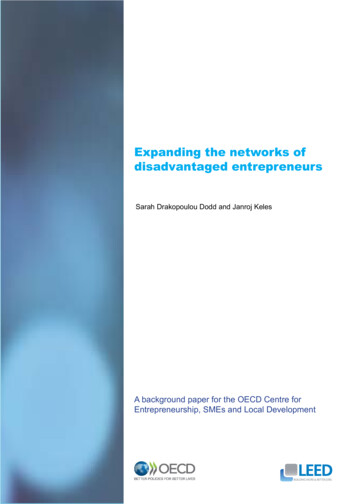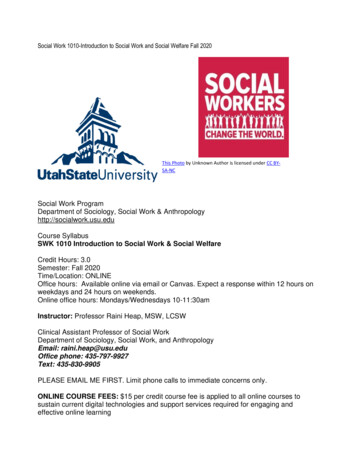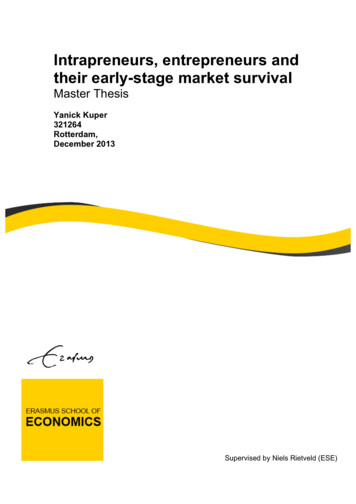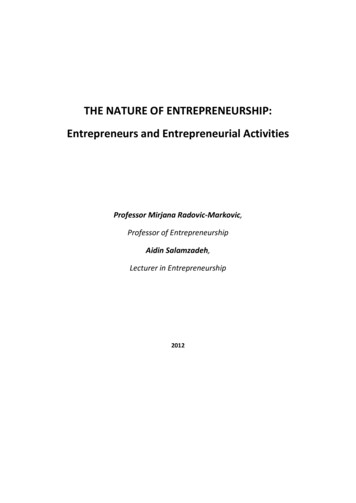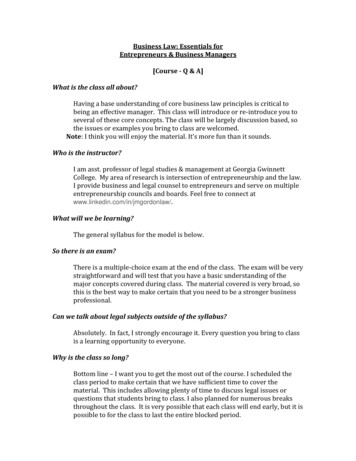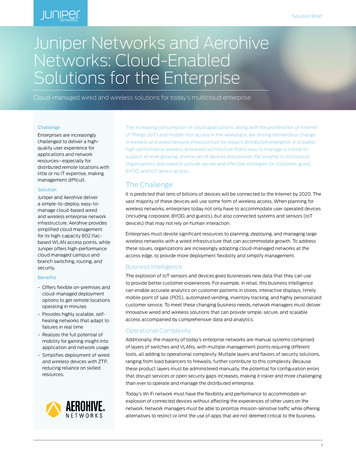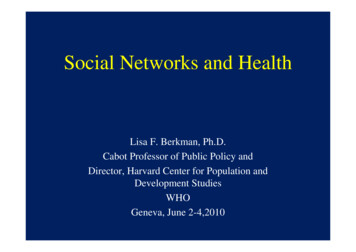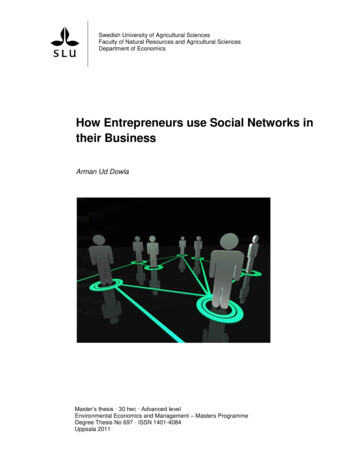
Transcription
Swedish University of Agricultural SciencesFaculty of Natural Resources and Agricultural SciencesDepartment of EconomicsHow Entrepreneurs use Social Networks intheir BusinessArman Ud DowlaMaster’s thesis · 30 hec · Advanced levelEnvironmental Economics and Management – Masters ProgrammeDegree Thesis No 697 · ISSN 1401-4084Uppsala 2011
How Entrepreneurs use Social Networks in their BusinessArman Ud DowlaSupervisor:Johan Gaddefors, Swedish University of Agricultural Sciences,Department of EconomicsExaminer:Karin Hakelius, Swedish University of Agricultural Sciences,Department of EconomicsCredits: 30 hecLevel: Advanced ECourse title: Independent project/degree in Business AdministrationCourse code: EX0536Programme/Education: Environmental Economics and Management Master’s ProgrammePlace of publication: UppsalaYear of publication: 2011Cover picture: www.buzz.comName of Series: Degree projectNo: 697ISSN 1401-4084Online publication: http://stud.epsilon.slu.seKey words: social networks, entrepreneurship, social capital, restaurateursSwedish University of Agricultural SciencesFaculty of Natural Resources and Agricultural SciencesDepartment of Economicsii
AcknowledgementFirstly, I would like to thank all the interviewee‟s for taking time out of their busy schedule togive me the opportunity to have an interview with them. I would not have been able to completethe paper without their vital contribution. I wish them all the success I future.I am also very thankful and appreciative of my supervisor, Johan Gaddefors, for the invaluablesupport and guidance throughout the entire time.Lastly, I am pleased to have such nice friends who helped me during the entire writing processand the length of my graduate studies.iii
iv
AbstractEvery individual have aspirations to be successful in life and to make it big one day; theapproach may differ from people to people, nevertheless ultimately individuals resort tobecoming an entrepreneur. However, it is not a simple task to become a businessmen, it takeslots of effort, resources or capital (labor, financial, technology) and other things that may bedeemed as important. For the purpose of gathering these aforementioned resources,entrepreneurs engage in social relationships (network) to gain access to information that mayultimately lead in the acquisition of such resources. In most literature, it has been suggested thatthe activation or use of social relationships (networks) is primarily done in the establishmentphase. Therefore, the objective of this paper is to disapprove such notions and further investigatethe phenomenon of social networking and social capital. As the field of entrepreneurship is quitebig, the study was de-limited to just restaurant owners. Through the process of primaryinvestigation (reflexive methodology), it has been unearthed that restaurateurs profusely use theirsocial network in their daily running of the establishment, and not just in the establishmentphase.v
ContentsAcknowledgement . iiiAbstract . v1.Introduction . 11.1.What is Entrepreneurship? . 11.2.Problem Background. 31.3.Research Questions . 41.4.Scoping . 41.5.Aim . 41.6.Structure of the Thesis . 42.Methodology. 62.1.Exploratory Research . 62.2.Qualitative Research . 72.3.Qualitative Interview . 72.4.Reflexive Methodology . 82.5.Types of interviews . 92.6.Ethnography . 102.7.Inductive Reasoning . 102.8.The Sample and Research Techniques . 112.9.Data Analysis . 133.Literature Review . 153.1.4.Past literature on Social Networking . 15Theoretical Framework . 214.1.Foreword to entrepreneurship . 214.2.Entrepreneurial Model. 224.2.1.Identification and Evaluation of the Opportunity . 224.2.2.Development of the Business Plan . 234.2.3.Determine the resources required . 234.2.4.Managing the enterprise. 244.3.Characteristics of Social Network . 244.3.1.Role Set . 254.3.2.Action Set . 25vi
4.3.3.4.4.Network . 25Critical Dimension of Networks . 254.4.1.Density . 254.4.2.Reachability . 264.4.3.Centrality . 264.4.4.Size . 264.4.5.Composition . 264.4.6.Focus . 264.5.Network Construction . 274.6.Conceptual Framework . 295. Empirical Findings . 305.1. Entrepreneur ‘A’ (Goh Yu Chong), Restaurant: Wok n Roll Thai restaurant in Södertälje,Stockholm. . 305.2.Entrepreneur ‘B’ (Mrs. Panyawai), Thai Restaurang in Västerbotten County . 315.3.Entrepreneur ‘C’ (Arshpreet Singh), Indisk Restaurang in Stockholm . 335.4.Entrepreneur ‘D’ (Mrs. Wei), Restaurant: Sushi Bar in Halmstad. 355.5.Entrepreneur E (Shamol), Restaurant: New India in Uppsala . 366.Analysis & Discussion . 386.1.Analysis of the empirical material. 386.2.Characteristics & Dimensions of Social network . 386.3.How entrepreneurs develop Social Networks . 426.4. How Entrepreneurs make use of their Social Networks in Other Phases of the BusinessLifecycle. 437.Conclusion . 457.1.Closing Remarks . 45Bibliography . 47Literature and publications . 47vii
List of TablesTable 1 Respondents . 12List of FiguresFigure 1 Outline of the thesis . 5Figure 2 Methodological Approaches / Strategy . 11Figure 3 Hydrogen bonding in water . 18Figure 4 Weak - Strong tie (adopted from Granovetter 1973) . 18Figure 5 A model of the Entrepreneurial Process (adopted from Moore 1986) . 21Figure 6 Network Expansion (adopted from Burt 1992). 27Figure 7 Examples of egocentric networks (adopted from baker 2000) . 28Figure 8 Example of a complete network (adopted from baker 2000) . 28Figure 9 Conceptual Framework (adopted from Blad 2008, p 31) . 29Figure 10 Arshpreet's complete network . 40viii
1. IntroductionThis chapter presents background information on the topic (social networking) under discussion. Theproblem background focuses on entrepreneurs and entrepreneurship, networking and social capitalwhich provide a foundation for the research problems. The chapter ends with the aim and objectives ofthe paper and also provides a brief outline of the rest of the study.1.1.What is Entrepreneurship?The field of entrepreneurship has been quite relatively researched and the likely cause could bethe generous contributions it makes to public policy goals, such as economic growth, creation ofemployment, innovation in technology, enhancement of productivity and structural realignments(Shane 1996). There could be many more other reasons for studying / researchingentrepreneurship but the goal here is not to explain „why‟ but „how‟ aspect of entrepreneurship.Generally speaking, people would be more interested in knowing how the process ofentrepreneurship initiates or what the activities of an entrepreneur are. If we are to define whatan entrepreneur is, then the definition would be a “person who owns, launches and assumes therisk of an economic venture1”, as defined by Gartner et al, (1994, p 6). It may also include peoplewho have bought an existing business (Gartner, et al. 1994). This definition is very simple, easyto understand, straightforward and is applicable to all kinds of entrepreneurs – social, serial, and
entrepreneurs engage in social relationships (network) to gain access to information that may ultimately lead in the acquisition of such resources. In most literature, it has been suggested that the activation or use of social relationships (networks) is primarily done in the establishment phase. Therefore, the objective of this paper is to disapprove such notions and further investigate
